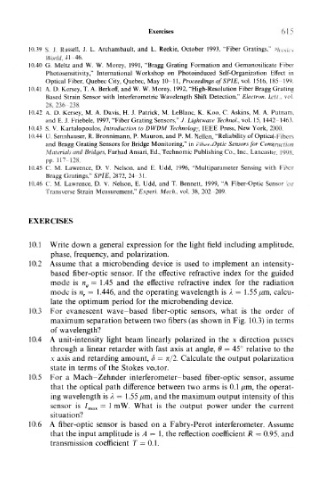Page 631 - Introduction to Information Optics
P. 631
Exercises 615
10.39 S. J, Russell, J. L. Archambault, and L. Reekie, October 1993, "Fiber Gratings." Physics
World, 41 .-46.
10.40 G. Meltz and W. W. Morey, 1991, "Bragg Grating Formation and Gemanosilicate Fiber
Photosensitivity," International Workshop on Photoinduced Self-Organization Effect in
Optical Fiber, Quebec City, Quebec, May 10--11, Proceedings ofSPIE, vol. 1516, 185 199.
10.41 A. D. Kersey, T. A. Berkoff, and W. W. Morey, 1992, "High-Resolution Fiber Bragg Grating
Based Strain Sensor with Interferometric Wavelength Shift Detection," Electron. Lets,, vol.
28, 236-238.
10.42 A. D. Kersey, M. A. Davis, H. J. Patrick, M. LeBlanc, K. Koo, C. Askins, M. A. Putnam,
and E. J. Friebele, 1997, "Fiber Grating Sensors," J, Lightwave Technol., vol. 15, 1442-1463.
10.43 S. V. Kartalopoulos, Introduction to DWDM Technology, IEEE Press, New York, 2000.
10.44 U. Sennhauser, R. Bronnimann, P. Mauron, and P. M. Nellen, "Reliability of Optical-Fibers
and Bragg Grating Sensors for Bridge Monitoring," in Fiher-Optic Sensors for Construction
Materials and Bridges, Farhad Ansari, Ed., Technomic Publishing Co., Inc., Lancaster, 1998,
pp. 117-128.
10.45 C. M. Lawrence, D. V. Nelson, and E. Udd, 1996, "Multiparameter Sensing with Fiber
Bragg Gratings," SPIE, 2872, 24-31.
10.46 C. M. Lawrence, D. V. Nelson, E. Udd, and T. Bennett, 1999, "A Fiber-Optic Sensor for
Transverse Strain Measurement," Expert. Mech.. vol. 38, 202 209.
EXERCISES
10.1 Write down a general expression for the light field including amplitude,
phase, frequency, and polarization.
10.2 Assume that a microbending device is used to implement an intensity-
based fiber-optic sensor. If the effective refractive index for the guided
mode is n g = 1.45 and the effective refractive index for the radiation
mode is n r = 1.446, and the operating wavelength is X = 1.55/mi, calcu-
late the optimum period for the microbending device.
10.3 For evanescent wave-based fiber-optic sensors, what is the order of
maximum separation between two fibers (as shown in Fig. 10.3) in terms
of wavelength?
10.4 A unit-intensity light beam linearly polarized in the x direction passes
through a linear retarder with fast axis at angle, 9 = 45° relative to the
x axis and retarding amount, 8 = n/2. Calculate the output polarization
state in terms of the Stokes vector.
10.5 For a Mach-Zehnder interferometer-based fiber-optic sensor, assume
that the optical path difference between two arms is 0.1 /mi, the operat-
ing wavelength is 1 = 1.55 /mi, and the maximum output intensity of this
sensor is 7 max = 1 mW. What is the output power under the current
situation?
10.6 A fiber-optic sensor is based on a Fabry-Perot interferometer. Assume
that the input amplitude is A = 1, the reflection coefficient R — 0.95, and
transmission coefficient T = 0.1.

